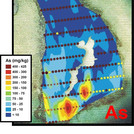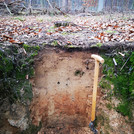Soil science and habitat ecology
Lead: Dr. Beate Gall
Soils and living organisms are mutually dependent. Living organisms need soils as a habitat and as a source of nutrients; soils are formed by the mixing of inorganic rock material and organic substances. These organic substances can consist of dead plants and animals or of organic compounds newly built up by microorganisms. Taken together, these organic substances form humus. The soil is also permeated by a pore system through which water and air enter it. The organisms and roots in soils need both to live, i.e. to breathe and to absorb nutrients. This pore system is in turn created by organisms such as earthworms, but also arises from physicochemical processes in the soil. Soils are therefore extremely complex systems in which living organisms, rock material, water and gas (air) meet. These four "phases" develop in interaction with climate and landscape history to form the diverse soil types that form the basis of terrestrial life and biodiversity. Soils enable humans to produce food or store water and thus significantly influence the landscape water balance. Soils also store carbon and thus contribute to controlling the carbon dioxide content in the atmosphere and thus the climate. The loss of soils therefore means food insecurity, a disturbed water balance, climate instability and loss of species and habitats. Soils are therefore a very high, vital asset of every society and must be preserved at all costs.
Site science deals with the conditions that animal and plant species require "on site". Climate and soil properties, such as nutrient and water availability, enable certain species to win the competition for sites against other species and to establish themselves accordingly on these sites. The resulting biotic communities are called biocenoses, their habitats biotopes. Thus, soil properties are reflected in biocenoses. Climate change, species loss, soil erosion, compaction and sealing threaten our natural livelihoods. Only knowledge of the site requirements of the various species enables sustainable management of the use of our landscapes.
In our working group, we deal with the interactions between soils and plants or with the importance of soils for biotopes, with the soil water balance, with pollutant loads and with fundamental biogeochemical processes in soils. We work on the development of soils in the context of landscape development, on soils as carbon sinks or on pollutant-releasing or pollutant-fixing biogeochemical processes in soils. An important aspect of our work is to communicate the importance of soils as the basis of all life to the public in a target group-specific way. Specifically, we work on, among other things
- the importance of the soil water balance for biocoenoses in water protection areas of the drinking water supplier of the city of Bühl,
- the carbon balance of agricultural land in Brandenburg,
- the protection of moorland soils in Brandenburg,
- the consideration of site and pedological aspects in floristic settlement measures
- pollution with perfluorinated hydrocarbons in Baden-Baden and Bühl,
- the arsenic contamination of agricultural soils in East and Southeast Asia
- Approaches to promote greater soil awareness.






